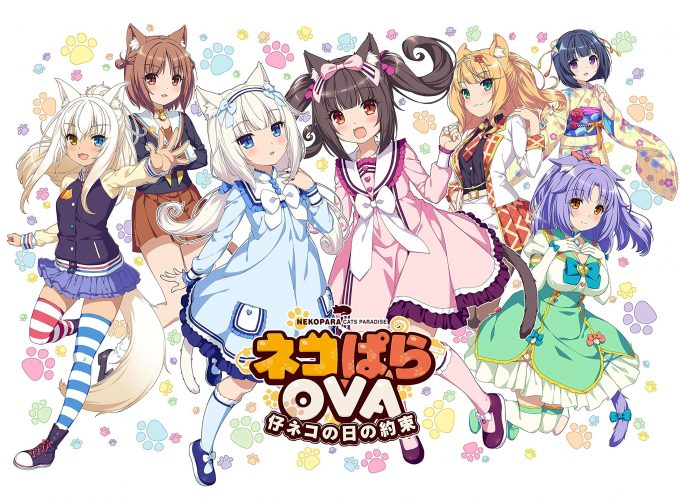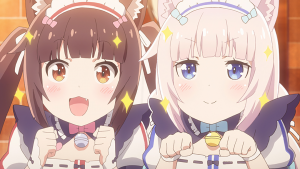
Nekopara is a sweet little seasonal anime based on the visual novel of the same name about catgirls living a peaceful life together with their human companions and working at a patisserie. They’re all named after dessert flavors and even have an adorable kitten friend who joins their family after she follows them home. What could possibly be horrific about such a pure, pleasant, and positively moe concept? Well... you’re about to find out.
Hidden underneath the candy-coated surface lies a sinister truth that, once discovered, will transform this show from a weekly dose of wholesome cuteness to a weekly reminder that humanity will never reach true salvation. This is... the existential horror of Nekopara.
What Even Are These Creatures?
First of all, what exactly are catgirls in this universe? Many fantasy anime establish cat people as their own separate species with a history and culture all their own, while Magical Nyan Nyan Taruto (an early 2000s anime that may have served as inspiration for Nekopara) explicitly states that its characters are regular cats who viewers see as humanoid because they think of themselves as equal to their human owners.
This show refers to its catgirls as simply “cats” and never indicates that the real-world version exists alongside them, or any other real-world animals for that matter. Chocola, Vanilla, Azuki, Coconut, Maple, Cinnamon, and Cacao are based on real cat breeds, age at the same rate as cats (appearing as teens or young adults, even though the eldest is only three years old), and frequently get into realistic catfights complete with presenting and hissing, so it’s fair to assume that their humanoid traits only extend to their appearance and ability to speak. But what does that mean for their brains? They’re clearly at least as intelligent as normal animals, but do they have dreams and desires of their own, separate from those of their owners Kashou and Shigure? And speaking of owners...
How Do Catgirls Fit Into Society??
Why do people in this world keep catgirls as pets, anyway? Owning another human is obviously horrible, but it’s perfectly fine to treat catgirls as though they’re animals? A throwaway line establishes that catgirls have to pass a difficult exam to earn a bell that they wear around their neck, which gives them permission to walk around in public without their owners. On top of that, Chocola and Vanilla and the rest of the gang work at the patisserie only out of a desire to help Kashou and Shigure, not for any kind of monetary compensation. Sometimes they eat normal food at the table with their owners, but they’ve also been shown to eat canned cat food. One episode mentions that young catgirls pee on the floor, but another implies that they use human toilets when they grow up.
If they truly are mentally subhuman creatures whose only desires are to please their human masters, what does that say about the society that exists around them? Even if you ignore the uncomfortable implications, this world still has issues that the anime tries to bury under the cutesy antics of its main characters. But we noticed, Nekopara. We noticed everything.
Where’s the Holy Water???
Remember when we said that this show is based on a visual novel? Well, in the game, it’s clear from dialogue and optional R-rated scenes that the point-of-view character Kashou has intimate sexual relationships with every single one of the catgirls (thankfully excluding the kitten Cacao, who is exclusive to the anime). Not only is he sleeping with people (?) he legally owns, but several of the girls are sisters and Chocola and Vanilla are still underage even if you’re going by cat years. Nothing this explicit occurs in the anime, of course, but there’s still an unfortunate level of sexualization going on that implies Kashou may still be boinking the cats offscreen.
Cinnamon is constantly horny, there’s an entire scene devoted to measuring the catgirls’ growth and comparing breast sizes, risqué jokes and ecchi moments pop up everywhere, and the endcards for each episode often feature characters in compromising positions and revealing outfits. Not even Cacao is safe—Cinnamon interprets Cacao hiding from Kashou in a box as “erotic roleplay” and a particularly unholy endcard shows the kitten tangled up in yarn in a manner reminiscent of shibari rope bondage. Sexualization is fine when everyone is a consenting adult, but “consenting” and “adult” are such vague terms in Nekopara that any attempt at titillation comes off as deeply uncomfortable.
Final Thoughts

Look, if you have the mental fortitude to ignore the ethical trainwreck that is the worldbuilding in this show and can just focus on cute catgirls doing cute catgirl things, then we applaud you. But for us, every episode of Nekopara is another nail in the coffin for our faith in humanity. With these thoughts ever-present in our minds, we can never go back to the way things once were. Nekopara is true terror... personified by catgirls.
What did you think of our deep dive into the existential horror of Nekopara? Have you noticed the same things we have? Are you able to enjoy it in spite of that? Let us know in the comments, and thanks so much for reading!
Recommended Post
6 Anime Like Nekopara [Recommendations]
Recommended Post




